Broadcom Launches Wi-Fi 7 Portfolio for Access Points and Client Devices
by Ganesh T S on April 12, 2022 9:00 AM EST- Posted in
- Networking
- Broadcom
- Wi-Fi
- Access Points
- Wi-Fi 7
- 802.11be

The last few years have seen heightened consumer focus on wireless networking. The industry has also been quite busy, enabling the operation of Wi-Fi 6 (802.11ax) in the 6GHz band with Wi-Fi 6E. In parallel, the 802.11 Working Group had started work on 802.11be with a focus on extremely high throughput (EHT). Wi-Fi 7 is set to become the consumer-facing moniker for 802.11be.
802.11be aims to achieve high throughput primarily through a combination of three aspects:
- Support for up to 16 spatial streams
- Support for channel widths up to 320MHz (with operation in 2.4 GHz, 5 GHz, and 6 GHz bands)
- Support for 4096-QAM (4K-QAM) resulting in better utilization of available spectrum (a faster modulation / coding scheme).
Theoretically, these aspects allow for up to around 46 Gbps of wireless throughput. 802.11be also aims to enable usage of Wi-Fi for real-time applications by including features for low-latency communications such as Multi-link operation (MLO). This allows a client and an access point to simultaneously communicate over multiple channels that might even belong to different bands. Interference and co-existence with non-Wi-Fi users of the same spectrum is handled using automatic frequency coordination (AFC).
A number of additional features targeting these two thrust areas are under consideration for the final standard. However, multiple silicon vendors have already started introducing silicon supporting variations of the aspects included in the first 802.11be draft specifications.
Mediatek was one of the first vendors to demonstrate working 802.11be-compliant silicon earlier this year. Though Mediatek indicated that the products would be marketed under the Filogic lineup, concrete technical details and part numbers were not announced. At MWC 2022, Qualcomm provided details of their 802.11be client silicon targeting mobile devices. The FastConnect 7800 is expected to become available in H2 2022, and integrates Bluetooth 5.3 support with key Wi-Fi 7 features.
Broadcom is announcing a comprehensive portfolio of products targeting various Wi-Fi 7 markets today.
The table below summarize the key features of the products targeting access points. All of these support 4K-QAM and Multi-Link Operation.
| Broadcom 802.11be (Wi-Fi) Access Point Radios Specifications | ||||
| BCM67263 | BCM6726 | BCMN43740 | BCMN43720 | |
| Target Market | Residential Wi-Fi APs | Enterprise Wi-Fi APs | ||
| Operational Band | 6 GHz | 2.4 GHz (or) 5 GHz (or) 6 GHz | ||
| Stream Count | 4 | 2 | ||
| Max. Channel Width | 320 MHz | 160 MHz | 320 MHz | 160 MHz |
| PHY Rate | 11.5 Gbps | 5.75 Gbps | 11.5 Gbps | 2.88 Gbps |
The AP products support AFC in order to ensure that 6GHz range is not affected (the APs are mandated to receive regularly scheduled clearance from a central authority to prevent interference with 6 GHz spectrum users). Broadcom has applied to be an AFC operator and will offer AFC service with their chips. This will use Open AFC code. Broadcom also believes a vibrant Wi-Fi 7 ecosystem requires an AFC service that the device makers can use independent of the chip vendor. Organizations such as the Wi-Fi Alliance, and Wireless Broadband Alliance have applied to be AFC operators, with Open AFC already gaining traction in this.
Tying these together in Broadcom's Wi-Fi 7 router reference design is the BCM4916 network processor. This ARM v8-compatible quad-core SoC includes a dual-issue Runner packet processor (DI-XRDP), an integrated NBASE-T (up to 10G) Ethernet PHY for WAN or LAN, four integrated 1GbE PHYs, three USXGMII interfaces, multiple USB ports, and a 32-bit DDR3/DDR4 DRAM interface.
The quad-core CPU is a custom Broadcom design with 64KB of L1 cache and 1MB of L2 cache, providing up to 24K DMIPS horsepower. Without the knowledge of exact clock speeds, it is difficult to compare against the standard Cortex cores from ARM. Based on the DMIPS number, this appears to slot in-between a Cortex-A53 and an A57, but does not include the ARM v8.2 features of the A55.
Broadcom's customers can play around with the radio configuration in the above design to create products at different price points. Tri-band support becomes compulsory in Wi-Fi 7. The extremely high throughput enabled by this means that 10G support on the WAN/LAN side and NBASE-T support on the LAN front will become the de-facto standard for routers and APs in the coming years.
Broadcom is also introducing the BCM4398 - an integrated Wi-Fi 7 and Bluetooth 5 combo chip targeting smartphones and other mobile applications. It supports two streams of Wi-Fi 7, channel width of up to 320 MHz, and a 6.05 Gbps PHY rate. On the client side, one of the key user-visible updates is low-latency operation. Broadcom claims that the BCM4398 can achieve sub-millisecond latencies for lightly congested environments in the 6 GHz band. The client multi-link operation feature can keep both uplink and downlink latencies between 5 and 10ms in situations where both 5 and 6 GHz bands are highly congested. This provides determinism for AR/VR knowing that worst case latencies will be down to a few milliseconds even during heavy congestion.
Broadcom is the first vendor to announce a complete portfolio of Wi-Fi 7 products, with sampling for key customers already in progress. The new products should give end-consumers a taste of the values delivered by Wi-Fi 7 for different applications a few quarters from now.


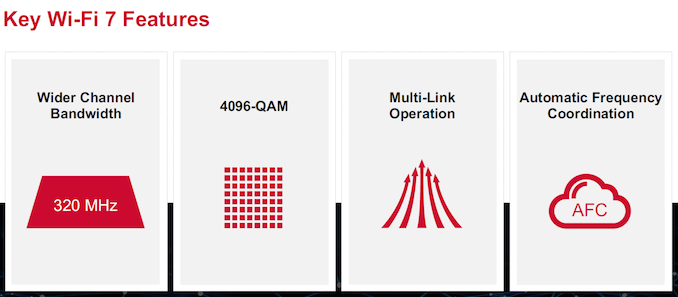
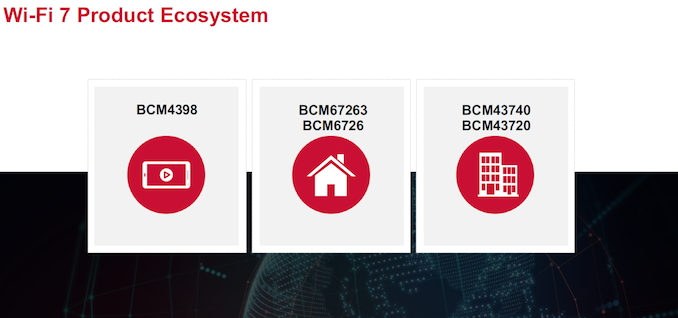
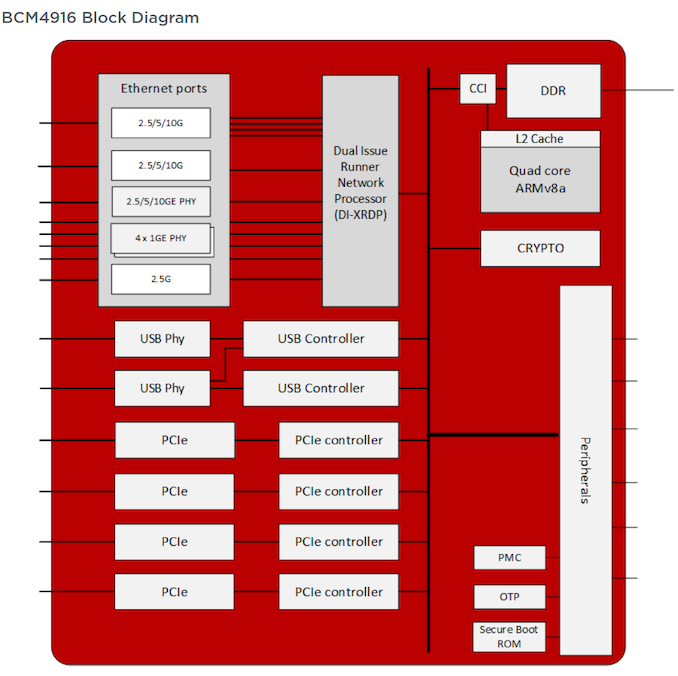
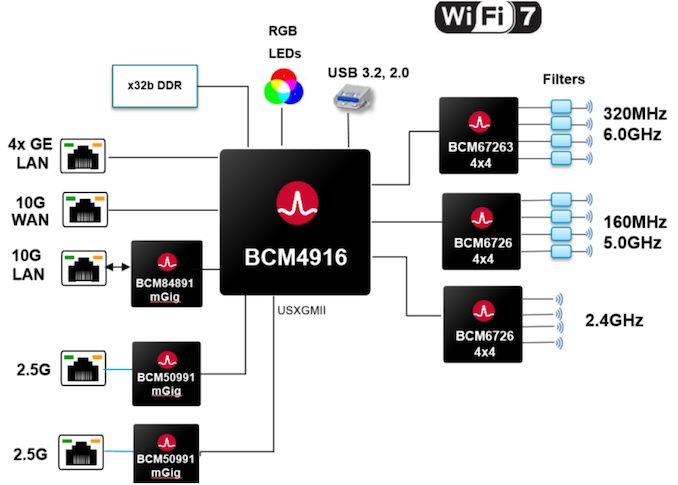
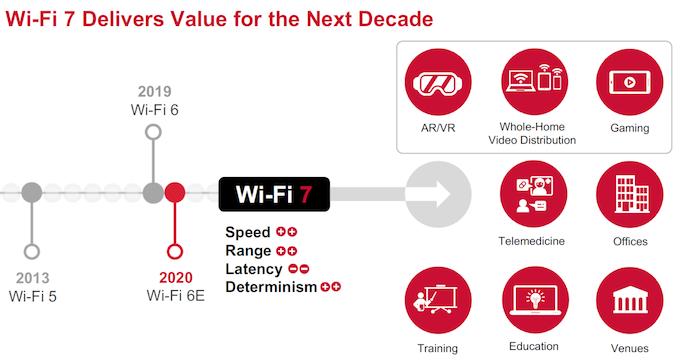














26 Comments
View All Comments
Kevin G - Tuesday, April 12, 2022 - link
802.11be is a huge step forward as it'll be able to pull off time sensitive networking (TSN 802.1Qbv) wirelessly. That is the functionality that'll provide the determinism. The downside is that to bridge that fully across a network, not only will a Wi-fi 7 router be needed but also TSN capable networking switches.Jp7188 - Wednesday, April 13, 2022 - link
I'm super excited for what this means for VR. Existing wireless VR hardware is extremely limited.phoenix_rizzen - Tuesday, April 12, 2022 - link
Urgh, why do they keep increasing the supported channel width, especially on consumer-grade routers/APs? Have they not learned the lessons from 2.4 GHz wireless, and the lack of non-overlapping channels?Yes, it's great they made an extra 1.2 GHz of spectrum available in the 6 GHz range. But what's the point if they turn around and provide only 3 non-overlapping 320 MHz channels in that range?
The promise of 5 GHz providing a large number of 20/40/80 MHz channels available has gone the way of the Dodo now that 160/320 MHz channels are supported. Because you *know* the crappy ISP-provided routers are going to use the biggest channel width possible *by default* and no one is going to change it. Anyone living in apartment/condo/townhouse complexes is going to find their Wifi 6/7 networks working no better than the Wifi 3/4 networks due to congestion. :( (Yes, 5/6 GHz doesn't propagate as far as 2.4 GHz does, but in cramped buildings it's still going to be a mess of 320 MHz channels broadcast at max power.)
supercaliber - Tuesday, April 12, 2022 - link
I would agree except for one important point--the 6Ghz spectrum is extremely impeded by walls. So much so that the recommended deployment plan is to have an AP in nearly every room because the penetration through obstacles is so poor. This makes deployment more difficult, but in many areas becomes a Feature as the interference is much less of a concern and you can actually take advantage of that wide channel bandwidth. New home builds should be putting a Cat6e jack in every single room if they want to future proof at all. Cheap 6Ghz APs in all the important high bandwidth rooms (Roku TVs, Playstations, laptops, etc.) and 5Ghz for coverage in the non-AP rooms creates a pretty decent deployment. In busy areas, 2.4GHz is basically unusable.DanNeely - Wednesday, April 13, 2022 - link
I think you're confusing 6GHz with 60GHz. 60's MMwave and is in-room only. The 6ghz band is adjacent to 5ghz band and only has marginally worse penetration as a result.supercaliber - Tuesday, April 19, 2022 - link
60 is purely line of sight (I used to build 60GHz P-MP radios for a failed wireless broadband startup). I'd have to look at 6Ghz again, but I was surprised at the attenuation inside a standard American home due to walls, bookshelves, cabinets, etc. It was more than just marginally worse than 5.Jp7188 - Wednesday, April 13, 2022 - link
...or if you're running that many jacks in a new home... you could just plug in all your high bandwidth devices and have a foolproof, consistent experience.DougMcC - Tuesday, April 12, 2022 - link
Haven't you heard? We're all moving out of the cities and telecommuting. No more cramped apartments!shadowx360 - Wednesday, April 13, 2022 - link
Not likely to be an issue.1) 6GHz band range is MASSIVE, literally more than double that of 5+2.4 GHz, and can fit 7 channels of 160 MHz.
2) The range for 6GHz is also very limited through walls so you’ll likely not see many nearby 6 gHz networks (fewer than 5 GHz)
3) Most importantly, WiFi 7 will support non-contiguous bands/channels so as long as there is a total of 320 MHz free anywhere in the entire 2.4+5+6 GHz bands, you can link them together dynamically. You are extremely unlikely to live next to 10 people actively saturating all bands.
Jp7188 - Wednesday, April 13, 2022 - link
I work on a network in a large city and the APs on upper floors detect hundreds of foreign APs. I looked at one the other day that had 268 neighbors. I'm always happy to see advancements, but there will continue to be problematic areas in dense deployments. It will continue to get better as older clients and APs are turned off.